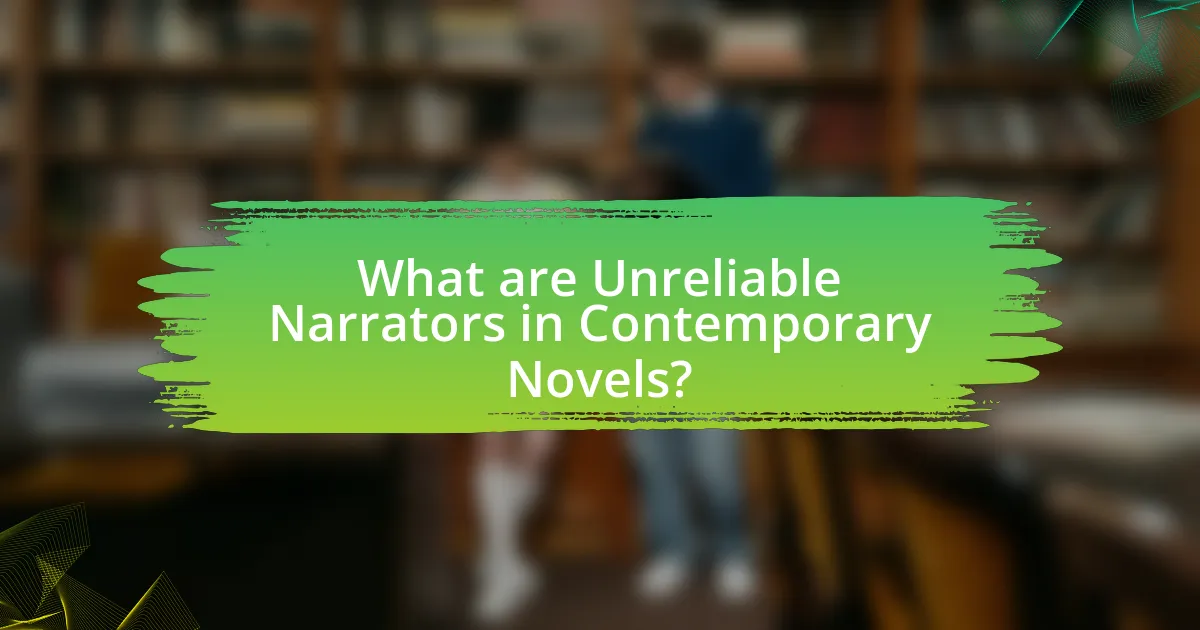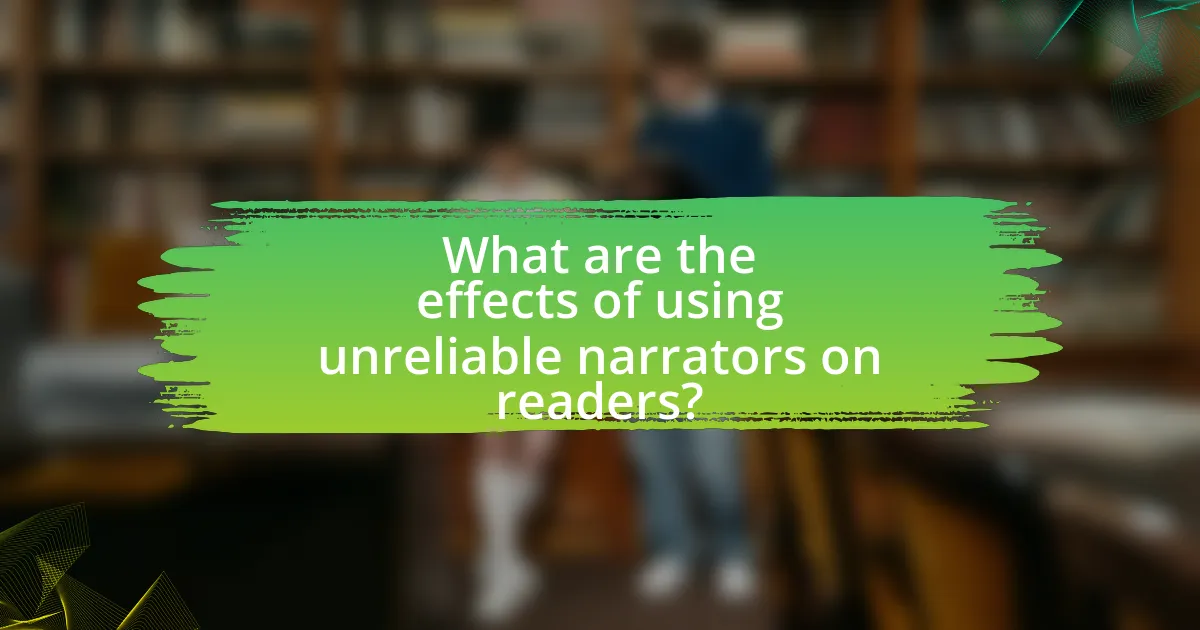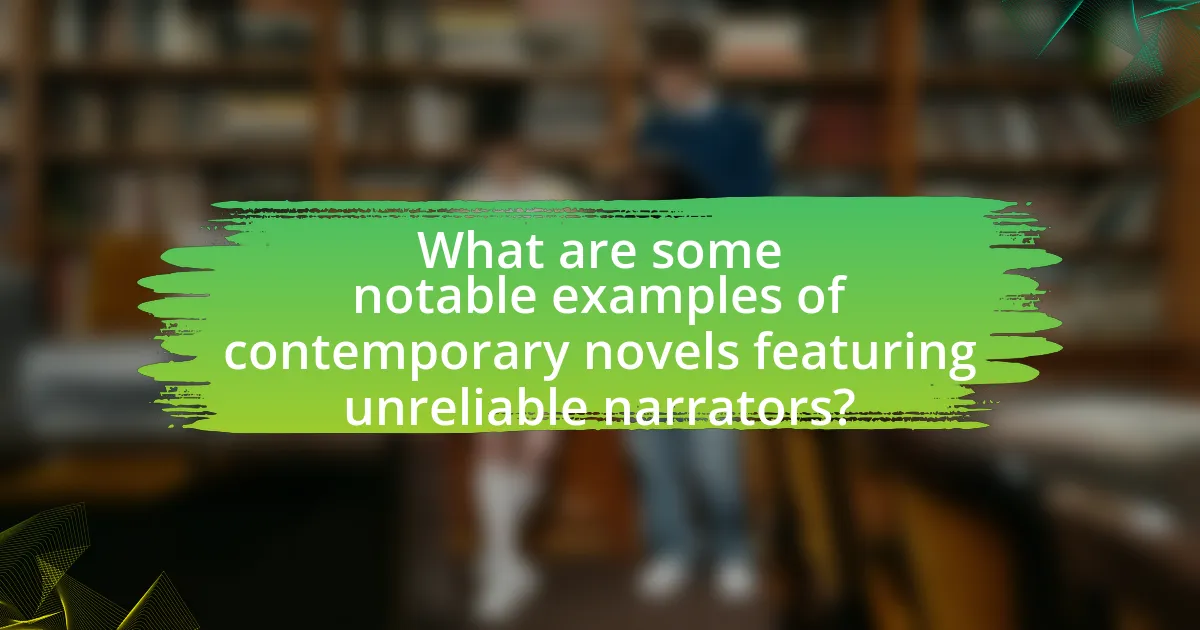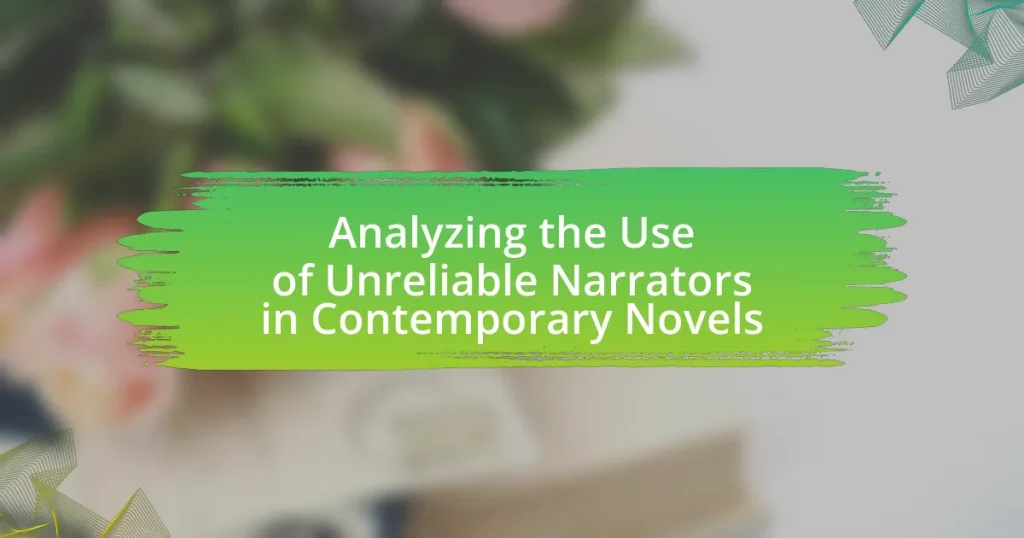Unreliable narrators are characters in contemporary novels whose credibility is compromised, prompting readers to question the truth of their accounts. This article analyzes the characteristics, distinctions, and psychological effects of unreliable narrators, highlighting their role in enhancing narrative complexity and engaging readers. It explores notable examples such as “The Catcher in the Rye” and “Gone Girl,” illustrating how these narrators challenge perceptions of reality and truth. Additionally, the article discusses techniques authors can use to effectively implement unreliable narrators in their writing while avoiding common pitfalls.

What are Unreliable Narrators in Contemporary Novels?
Unreliable narrators in contemporary novels are characters whose credibility is compromised, leading readers to question the truth of their accounts. This narrative technique is often employed to create ambiguity, enhance themes of perception versus reality, and engage readers in critical analysis of the story. For instance, in “The Catcher in the Rye” by J.D. Salinger, the protagonist Holden Caulfield presents a skewed perspective that reflects his mental state, prompting readers to discern the underlying truths of his experiences. This method has been widely recognized in literary studies, illustrating how unreliable narrators can deepen the complexity of storytelling and challenge readers’ interpretations.
How do unreliable narrators differ from reliable narrators?
Unreliable narrators differ from reliable narrators primarily in their credibility and the accuracy of their accounts. Unreliable narrators intentionally or unintentionally distort the truth, leading readers to question their perspective, while reliable narrators provide consistent and trustworthy information that aligns with the narrative’s events. For example, in novels like “The Catcher in the Rye,” Holden Caulfield’s subjective viewpoint creates doubt about his reliability, contrasting with a character like Nick Carraway in “The Great Gatsby,” who offers a more objective recounting of events. This distinction is crucial in contemporary literature, as it shapes readers’ interpretations and engagement with the story.
What characteristics define an unreliable narrator?
An unreliable narrator is characterized by a lack of credibility, often due to personal biases, mental instability, or intentional deceit. These narrators may present distorted perceptions of reality, leading readers to question the truth of their accounts. For example, in “The Catcher in the Rye,” Holden Caulfield’s subjective viewpoint and emotional turmoil create a narrative that is skewed by his personal experiences and biases, making him an unreliable source of information. This characteristic forces readers to actively engage with the text to discern the underlying truths, highlighting the complexity of narrative perspective in literature.
How do readers identify unreliable narrators?
Readers identify unreliable narrators through inconsistencies in their accounts, contradictions in their statements, and a lack of credibility. These narrators often present biased perspectives, omit critical information, or display emotional instability, which signals to readers that their version of events may not be trustworthy. For example, in novels like “The Catcher in the Rye” by J.D. Salinger, the protagonist Holden Caulfield frequently contradicts himself and exhibits paranoia, prompting readers to question his reliability. This pattern of behavior serves as a clear indicator of an unreliable narrator, allowing readers to discern the truth behind the narrative.
Why are unreliable narrators used in contemporary literature?
Unreliable narrators are used in contemporary literature to create complexity and challenge readers’ perceptions of truth. This narrative technique allows authors to explore subjective realities, emphasizing the idea that truth can be multifaceted and influenced by personal biases. For instance, novels like “Gone Girl” by Gillian Flynn utilize unreliable narrators to manipulate the audience’s understanding of characters and events, thereby enhancing suspense and engagement. This approach not only deepens character development but also invites readers to question the reliability of their own interpretations, reflecting broader themes of deception and ambiguity in modern society.
What themes are often explored through unreliable narrators?
Unreliable narrators often explore themes of perception versus reality, truth and deception, and the subjective nature of experience. These themes highlight how personal biases and psychological states can distort narratives, leading to a complex interplay between what is presented and what is true. For instance, in novels like “The Catcher in the Rye” by J.D. Salinger, the protagonist’s skewed perspective reveals deeper truths about alienation and identity, illustrating how unreliable narration can serve to challenge readers’ understanding of reality.
How do unreliable narrators enhance narrative complexity?
Unreliable narrators enhance narrative complexity by introducing ambiguity and challenging readers’ perceptions of truth. This narrative technique forces readers to actively engage with the text, questioning the reliability of the narrator’s account and piecing together the underlying reality. For instance, in novels like “The Catcher in the Rye” by J.D. Salinger, the protagonist’s subjective viewpoint creates a layered understanding of events, prompting readers to discern between the narrator’s biases and the actual circumstances. This complexity enriches the reading experience, as it encourages critical thinking and deeper analysis of character motivations and themes.

What are the effects of using unreliable narrators on readers?
Using unreliable narrators affects readers by creating a sense of ambiguity and encouraging critical thinking. This narrative technique forces readers to question the truthfulness of the narrator’s account, leading to deeper engagement with the text. For instance, in novels like “The Catcher in the Rye” by J.D. Salinger, the protagonist’s skewed perspective prompts readers to analyze the reliability of his observations and motivations. This interaction enhances the reading experience by fostering a more active role in interpreting the story, ultimately leading to varied interpretations and discussions among readers.
How do unreliable narrators influence reader perception?
Unreliable narrators significantly influence reader perception by creating ambiguity and challenging the authenticity of the narrative. This technique compels readers to question the truthfulness of the narrator’s account, leading to a more active engagement with the text. For instance, in novels like “The Catcher in the Rye” by J.D. Salinger, the protagonist’s subjective viewpoint skews the portrayal of events, prompting readers to discern underlying truths and motives. This interaction fosters a deeper understanding of themes such as alienation and identity, as readers must navigate the discrepancies between the narrator’s perspective and the reality of the story.
What psychological effects do unreliable narrators have on readers?
Unreliable narrators create psychological effects on readers by inducing feelings of confusion and skepticism. This narrative technique challenges readers to question the truthfulness of the story, leading to heightened engagement as they actively piece together the reality behind the narrator’s perspective. Research indicates that this engagement can enhance critical thinking skills, as readers must analyze inconsistencies and motives, fostering a deeper understanding of narrative structure and character psychology. For instance, studies have shown that readers of novels featuring unreliable narrators often report increased emotional investment and a more profound exploration of themes such as truth and perception, as seen in works like “The Catcher in the Rye” by J.D. Salinger and “Gone Girl” by Gillian Flynn.
How does reader engagement change with unreliable narrators?
Reader engagement typically increases with unreliable narrators due to the complexity and intrigue they introduce into the narrative. Unreliable narrators challenge readers to actively question the truth of the story, prompting deeper analysis and critical thinking. This engagement is supported by studies indicating that narratives featuring unreliable narrators often lead to heightened emotional investment and curiosity, as readers seek to discern the reality behind the narrator’s perspective. For instance, works like “Gone Girl” by Gillian Flynn exemplify this phenomenon, where the unreliable narration creates suspense and encourages readers to piece together the truth, thereby enhancing their overall engagement with the text.
What role does suspense play in narratives with unreliable narrators?
Suspense in narratives with unreliable narrators serves to heighten tension and engage readers by creating uncertainty about the truth of the narrator’s account. This uncertainty compels readers to question the reliability of the information presented, leading to a more active engagement with the text as they attempt to discern reality from deception. For example, in novels like “Gone Girl” by Gillian Flynn, the unreliable narration creates suspense by revealing conflicting perspectives that keep readers guessing about the characters’ true motivations and the actual events. This interplay between suspense and unreliability not only enhances the emotional impact of the story but also deepens the thematic exploration of truth and perception.
How do unreliable narrators create tension in storytelling?
Unreliable narrators create tension in storytelling by distorting reality, leading readers to question the truth of the narrative. This distortion often results in conflicting perspectives, where the narrator’s version of events clashes with the reader’s understanding or other characters’ accounts. For example, in novels like “Gone Girl” by Gillian Flynn, the protagonist’s deceptive portrayal of events keeps readers on edge, as they must navigate through layers of manipulation and hidden motives. This uncertainty heightens suspense and engages readers, compelling them to piece together the actual truth behind the unreliable narration.
What techniques do authors use to build suspense with unreliable narrators?
Authors build suspense with unreliable narrators through techniques such as selective revelation, contradictory statements, and emotional manipulation. Selective revelation involves withholding key information, which creates uncertainty and keeps readers guessing about the truth. Contradictory statements from the narrator can lead to confusion, prompting readers to question the narrator’s credibility and the reality of the events being described. Emotional manipulation occurs when the narrator evokes sympathy or distrust, influencing how readers perceive the unfolding story. These techniques effectively engage readers, making them actively piece together the narrative and heightening the overall suspense.

What are some notable examples of contemporary novels featuring unreliable narrators?
Notable examples of contemporary novels featuring unreliable narrators include “Gone Girl” by Gillian Flynn, “The Girl on the Train” by Paula Hawkins, and “Life After Life” by Kate Atkinson. In “Gone Girl,” the dual perspectives of Nick and Amy Dunne reveal conflicting truths, creating suspense and ambiguity. “The Girl on the Train” employs Rachel Watson’s distorted perceptions to challenge the reader’s understanding of reality. In “Life After Life,” Ursula Todd’s multiple lives and varying outcomes illustrate the complexities of memory and choice. These novels effectively utilize unreliable narration to engage readers and provoke critical thought about truth and perspective.
Which contemporary novels are recognized for their use of unreliable narrators?
Contemporary novels recognized for their use of unreliable narrators include “The Catcher in the Rye” by J.D. Salinger, “Gone Girl” by Gillian Flynn, and “The Girl on the Train” by Paula Hawkins. These novels feature narrators whose credibility is compromised, leading readers to question the truth of their accounts. For instance, in “Gone Girl,” the dual perspectives of Nick and Amy Dunne reveal conflicting narratives that manipulate the reader’s perception of reality, showcasing the effectiveness of unreliable narration in creating suspense and complexity.
What makes these novels stand out in their use of unreliable narration?
These novels stand out in their use of unreliable narration due to their complex characterizations and the intentional manipulation of perspective. Authors often craft narrators whose biases, mental states, or motivations distort the truth, compelling readers to question the narrative’s authenticity. For instance, in “Gone Girl” by Gillian Flynn, the dual perspectives of Nick and Amy create a layered understanding of deceit, as each character presents a skewed version of events that reveals deeper psychological truths. This technique not only enhances suspense but also engages readers in an active interpretation of the story, making them aware of the subjective nature of truth.
How do the narratives unfold in these examples?
The narratives in the examples unfold through the perspectives of unreliable narrators, who distort reality and challenge readers’ perceptions. These narrators often present subjective interpretations of events, leading to ambiguity and uncertainty in the storyline. For instance, in novels like “Gone Girl” by Gillian Flynn, the dual perspectives of the protagonists create conflicting narratives that keep readers questioning the truth. This technique engages readers by forcing them to piece together the actual events from the unreliable accounts provided. The use of unreliable narrators effectively enhances tension and complexity, as seen in “The Catcher in the Rye” by J.D. Salinger, where Holden Caulfield’s skewed viewpoint shapes the narrative’s emotional landscape.
What lessons can writers learn from these examples?
Writers can learn the importance of crafting complex characters and narratives from examples of unreliable narrators in contemporary novels. These narrators often challenge readers’ perceptions, demonstrating that ambiguity can enhance storytelling by creating tension and engagement. For instance, in “Gone Girl” by Gillian Flynn, the dual perspectives of the protagonists reveal how subjective experiences shape reality, teaching writers to explore multiple viewpoints to deepen character development and plot intricacy. Additionally, the use of unreliable narrators encourages writers to manipulate information strategically, as seen in “The Catcher in the Rye” by J.D. Salinger, where Holden Caulfield’s skewed perspective invites readers to question the truth, illustrating that selective storytelling can provoke critical thinking and emotional investment.
How can authors effectively implement unreliable narrators in their own writing?
Authors can effectively implement unreliable narrators by carefully crafting the narrator’s perspective to create doubt and ambiguity in the storytelling. This can be achieved through selective information sharing, where the narrator withholds key details or presents events in a biased manner, leading readers to question the truth of their account. For instance, in “The Catcher in the Rye,” J.D. Salinger uses Holden Caulfield’s subjective viewpoint to distort reality, prompting readers to discern the underlying truths. Additionally, authors can employ contradictions in the narrator’s statements or actions, further enhancing the sense of unreliability. This technique encourages readers to engage critically with the text, analyzing the discrepancies and forming their interpretations of the narrative.
What common pitfalls should writers avoid when using unreliable narrators?
Writers should avoid making their unreliable narrators too obvious, as this can diminish suspense and reader engagement. When the narrator’s unreliability is immediately apparent, it can lead to a lack of investment in the story, as readers may feel they can predict the outcome. Additionally, writers should refrain from over-explaining the narrator’s flaws, which can undermine the subtlety of the narrative. Instead, maintaining a balance between ambiguity and clarity allows readers to gradually uncover the truth, enhancing the overall experience. Lastly, writers must be cautious not to create narrators whose unreliability feels forced or contrived, as this can alienate readers and disrupt narrative flow.
What best practices can enhance the use of unreliable narrators in storytelling?
To enhance the use of unreliable narrators in storytelling, authors should focus on establishing a strong narrative voice that reflects the character’s biases and limitations. This can be achieved by incorporating inconsistencies in the narrator’s account, which prompts readers to question the truthfulness of the narrative. For instance, in “The Catcher in the Rye,” J.D. Salinger uses Holden Caulfield’s subjective perspective to create doubt about his reliability, engaging readers in a deeper analysis of his motivations and experiences. Additionally, layering the narrative with multiple perspectives can provide contrasting viewpoints that highlight the narrator’s unreliability, as seen in “Gone Girl” by Gillian Flynn, where alternating narratives reveal differing truths. These practices not only enrich the storytelling but also encourage critical thinking among readers, making the experience more immersive and thought-provoking.






